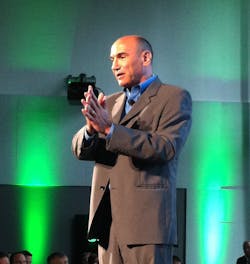Schneider Electric unveiled its new Boston One Campus in Andover, Mass., to industry press and analysts on September 11, 2014. The facility will serve as the company’s North American research & development center as well as its headquarters. The company’s previous North American headquarters was based in Palatine, Ill.
During his presentation at the event, Laurent Vernerey, president and CEO of Schneider Electric’s North America operations, said that, following the acquisition of Invensys this year, Schneider Electric now has the “portfolio we wanted to assemble.” With the company now having a foothold in both the discrete and process automation businesses, Schneider Electric is focused on continued “growth through solving customer problems,” he said. The principal markets Schneider Electric will focus on moving forward are: water/wastewater, utilities, food & beverage, oil & gas, data centers, metals/minerals/mining, and OEMs.
He added that Schneider Electric has “doubled the size of its business in the past 5 years” by building on its R&D focus in these markets, noting that 4-5 percent of the company’s of sales revenues are and will remain devoted to R&D.
Outlining the technology direction of Schneider Electric following the acquisition of Invensys, Pascal Brosset, chief technology officer for Schneider Electric, said that a major factor driving the company’s technology strategy is that “we are reaching the limit of traditional architectures. The data historian is reaching the end of its useful life with all data being collected now.”
As a result, he said both enterprise and control technologies are gravitating towards the Internet of Things and Big Data.
“Control systems are super smart, but they’re very focused and tend to lack context,” Brosset said. Leveraging a big data structure, he points out that companies can bring together data from enterprise and control systems as well as customer comments on social media to deliver the total context in which a modern business operates. There’s a “huge potential” upside to this, Brosset said, but “how do you do it?”
He contends the answer lies in “operational intelligence”, which will become the “center of gravity” for business technology; this "center of gravity" resides between the enterprise and control zones.
“Architectures will be constructed bottom-up and be data driven,” Brosset said, adding that this transformation will begin with the IP-enabling of all new devices in a plant or building. This data will reside on a company’s intranet-based network, where data services will filter, aggregate and correlate the data with relevant external data/events before integrating the whole into the business logic that will drive business decision making all the way down to the device level.
Brosset admits that this far reaching vision is currently just “marketecture, but it is what we're working on.” The 53,000 square feet of engineering laboratory space at the Boston One Campus is expected to play a major role in turning the company’s current vision into a viable software architecture.
Given Schneider Electric’s long-standing focus on energy management, it should be noted that the Boston One Campus is U.S. Green Building Council LEED Silver certified and uses some $8 million of Schneider Electric’s own products including the SmartStruxure integrated building management system; APC by Schneider Electric’s EcoAisle and EcoBreeze data center cooling systems, data center and server uninterruptible power supplies (UPS); Schneider Electric Altivar variable speed for HVAC control; “ultra-efficient” lighting from Juno Lighting Group by Schneider Electric; and intelligent IP security management systems from Pelco by Schneider Electric.


